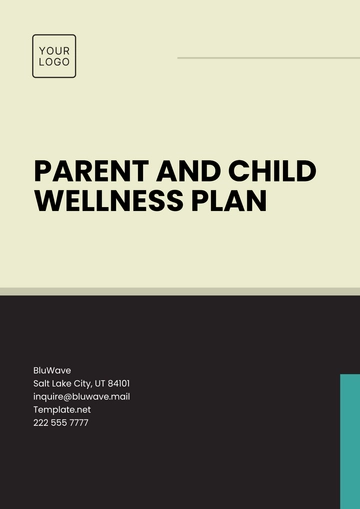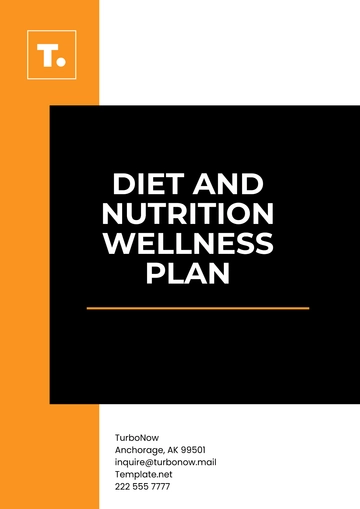Free Diet and Nutrition Wellness Plan

Prepared by: [Your Name]
Company: [Your Company Name]
Date: [Insert Date]
I. Introduction
The foundation of a healthy lifestyle begins with proper diet and nutrition. This Diet and Nutrition Wellness Plan is designed to provide a structured approach to fostering healthy eating habits, improving nutritional literacy, and supporting individuals in achieving their health and wellness goals. The plan integrates evidence-based dietary guidelines and practical strategies to ensure sustainability and long-term success.
II. Objectives
Improve Nutritional Awareness
Equip participants with knowledge about balanced diets, macronutrients, micronutrients, and food choices.Promote Healthy Eating Habits
Encourage portion control, mindful eating, and the inclusion of nutrient-dense foods.Support Weight Management
Provide tools and strategies for weight loss, weight maintenance, or weight gain based on individual needs.Prevent Chronic Diseases
Address dietary risk factors linked to diabetes, cardiovascular disease, hypertension, and obesity.Enhance Overall Well-Being
Support mental clarity, energy levels, and physical performance through optimized nutrition.
III. Key Components of the Plan
A. Education and Awareness
Strategies:
Conduct workshops on dietary basics, reading nutrition labels, and understanding food groups.
Distribute resources such as meal planning guides, recipe books, and nutritional fact sheets.
Create online modules or webinars for convenient access to information on balanced eating.
B. Personalized Nutrition Plans
Strategies:
Provide personalized meal plans based on age, gender, activity, and health goals.
Conduct assessments to identify dietary deficiencies or excesses.
Provide one-on-one consultations with registered dietitians or nutritionists.
C. Meal Preparation and Cooking Skills
Strategies:
Host cooking classes to teach participants how to prepare quick, healthy, and budget-friendly meals.
Share grocery shopping tips, including how to select fresh produce and avoid processed foods.
Encourage batch cooking and meal prepping to save time and promote consistent healthy eating.
D. Balanced Nutrition Guidelines
Key Focus Areas:
Macronutrient Distribution:
45–65% carbohydrates, focusing on whole grains, fruits, and vegetables.
10–35% protein from lean meats, fish, legumes, and plant-based sources.
20–35% healthy fats from nuts, seeds, avocado, and olive oil.
Micronutrient Intake:
Emphasize foods rich in vitamins (e.g., Vitamin C from citrus fruits) and minerals (e.g., calcium from dairy or fortified plant-based alternatives).
Hydration:
Encourage drinking 8–10 cups of water daily, with adjustments for activity levels and climate.
Portion Control:
Educate on portion sizes to prevent overeating and promote balanced meals.
E. Behavioral and Lifestyle Changes
Strategies:
Implement mindfulness techniques to reduce emotional or stress eating.
Promote the use of food diaries or apps to track meals, identify patterns, and set goals.
Encourage consistent meal timing to regulate metabolism and energy levels.
F. Community Support and Engagement
Strategies:
Develop peer support groups for accountability and motivation.
Host regular challenges (e.g., "30 Days of Healthy Eating") to foster community participation.
Create an online forum or social media group for recipe sharing and encouragement.
IV. Implementation Timeline
Phase 1 (Months 1-2):
Launch educational workshops and distribute nutritional resources.
Begin assessments for personalized meal plans.
Phase 2 (Months 3-4):
Host cooking classes and grocery shopping tours.
Provide initial feedback on participants’ progress and adjust meal plans as needed.
Phase 3 (Months 5-6):
Introduce behavioral coaching sessions and mindfulness training.
Organize community challenges and evaluate engagement levels.
Ongoing:
Monitor progress, offer continuous support, and update resources as needed.
V. Monitoring and Evaluation
A. Key Performance Indicators (KPIs)
Percentage of participants adopting recommended dietary changes.
Improvements in biometric data (e.g., weight, cholesterol, blood pressure).
Increased nutritional knowledge based on pre-and post-program surveys.
Higher participant satisfaction rates with the program.
B. Evaluation Methods
Conduct regular check-ins and surveys to gather feedback.
Analyze food diaries and meal tracking data for adherence to plans.
Compare health metrics before and after program participation.
VI. Resources and Tools
Digital Tools:
Meal-planning apps like MyFitnessPal or Cronometer.
Food tracking and grocery shopping lists.
Support Staff:
Registered dietitians, nutritionists, and fitness experts.
Educational Materials:
Handouts on healthy substitutions, cooking methods, and portion control.
Recipes for quick, nutritious meals.
Community Partnerships:
Collaborate with local farmers’ markets, grocery stores, and fitness centers.
VII. Sustainability and Long-Term Maintenance
Encourage participants to set realistic, long-term nutrition goals.
Transition from guided meal plans to self-sufficient planning and decision-making.
Build an alumni group for continued support and motivation.
Regularly update materials and workshops based on the latest dietary guidelines and participant feedback.
VIII. Conclusion
The Diet and Nutrition Wellness Plan provides a structured yet flexible approach to improving dietary habits, addressing nutritional deficiencies, and fostering a healthier lifestyle. By empowering individuals with knowledge, resources, and support, this plan promotes not just physical health but also mental clarity, energy, and overall well-being.
Through commitment and collaboration, this wellness plan can help participants achieve their health goals and maintain long-term dietary success.
- 100% Customizable, free editor
- Access 1 Million+ Templates, photo’s & graphics
- Download or share as a template
- Click and replace photos, graphics, text, backgrounds
- Resize, crop, AI write & more
- Access advanced editor
You may also like
- Finance Plan
- Construction Plan
- Sales Plan
- Development Plan
- Career Plan
- Budget Plan
- HR Plan
- Education Plan
- Transition Plan
- Work Plan
- Training Plan
- Communication Plan
- Operation Plan
- Health And Safety Plan
- Strategy Plan
- Professional Development Plan
- Advertising Plan
- Risk Management Plan
- Restaurant Plan
- School Plan
- Nursing Home Patient Care Plan
- Nursing Care Plan
- Plan Event
- Startup Plan
- Social Media Plan
- Staffing Plan
- Annual Plan
- Content Plan
- Payment Plan
- Implementation Plan
- Hotel Plan
- Workout Plan
- Accounting Plan
- Campaign Plan
- Essay Plan
- 30 60 90 Day Plan
- Research Plan
- Recruitment Plan
- 90 Day Plan
- Quarterly Plan
- Emergency Plan
- 5 Year Plan
- Gym Plan
- Personal Plan
- IT and Software Plan
- Treatment Plan
- Real Estate Plan
- Law Firm Plan
- Healthcare Plan
- Improvement Plan
- Media Plan
- 5 Year Business Plan
- Learning Plan
- Marketing Campaign Plan
- Travel Agency Plan
- Cleaning Services Plan
- Interior Design Plan
- Performance Plan
- PR Plan
- Birth Plan
- Life Plan
- SEO Plan
- Disaster Recovery Plan
- Continuity Plan
- Launch Plan
- Legal Plan
- Behavior Plan
- Performance Improvement Plan
- Salon Plan
- Security Plan
- Security Management Plan
- Employee Development Plan
- Quality Plan
- Service Improvement Plan
- Growth Plan
- Incident Response Plan
- Basketball Plan
- Emergency Action Plan
- Product Launch Plan
- Spa Plan
- Employee Training Plan
- Data Analysis Plan
- Employee Action Plan
- Territory Plan
- Audit Plan
- Classroom Plan
- Activity Plan
- Parenting Plan
- Care Plan
- Project Execution Plan
- Exercise Plan
- Internship Plan
- Software Development Plan
- Continuous Improvement Plan
- Leave Plan
- 90 Day Sales Plan
- Advertising Agency Plan
- Employee Transition Plan
- Smart Action Plan
- Workplace Safety Plan
- Behavior Change Plan
- Contingency Plan
- Continuity of Operations Plan
- Health Plan
- Quality Control Plan
- Self Plan
- Sports Development Plan
- Change Management Plan
- Ecommerce Plan
- Personal Financial Plan
- Process Improvement Plan
- 30-60-90 Day Sales Plan
- Crisis Management Plan
- Engagement Plan
- Execution Plan
- Pandemic Plan
- Quality Assurance Plan
- Service Continuity Plan
- Agile Project Plan
- Fundraising Plan
- Job Transition Plan
- Asset Maintenance Plan
- Maintenance Plan
- Software Test Plan
- Staff Training and Development Plan
- 3 Year Plan
- Brand Activation Plan
- Release Plan
- Resource Plan
- Risk Mitigation Plan
- Teacher Plan
- 30 60 90 Day Plan for New Manager
- Food Safety Plan
- Food Truck Plan
- Hiring Plan
- Quality Management Plan
- Wellness Plan
- Behavior Intervention Plan
- Bonus Plan
- Investment Plan
- Maternity Leave Plan
- Pandemic Response Plan
- Succession Planning
- Coaching Plan
- Configuration Management Plan
- Remote Work Plan
- Self Care Plan
- Teaching Plan
- 100-Day Plan
- HACCP Plan
- Student Plan
- Sustainability Plan
- 30 60 90 Day Plan for Interview
- Access Plan
- Site Specific Safety Plan





























